Intel Shares Alder Lake Pricing, Specs and Gaming Performance: $589 for 16 Cores
Here we go...
Intel Alder Lake Overclocking
Intel 7 marks our first view of what Intel's previously-known-as-10nm node can do in the land of desktop PC overclocking. As Intel's first new node in six years, enthusiasts are eager to see if the chips open up new levels of overclocking frequency headroom.
As always, Intel isn't making firm commitments to overclocking headroom, though there are a few encouraging signs in some of its automated overclocking features. However, if one thing is certain, it is that Intel has plenty of features ready for enthusiasts to poke at nearly every setting imaginable, including new knobs for E-core and DDR5 overclocking.
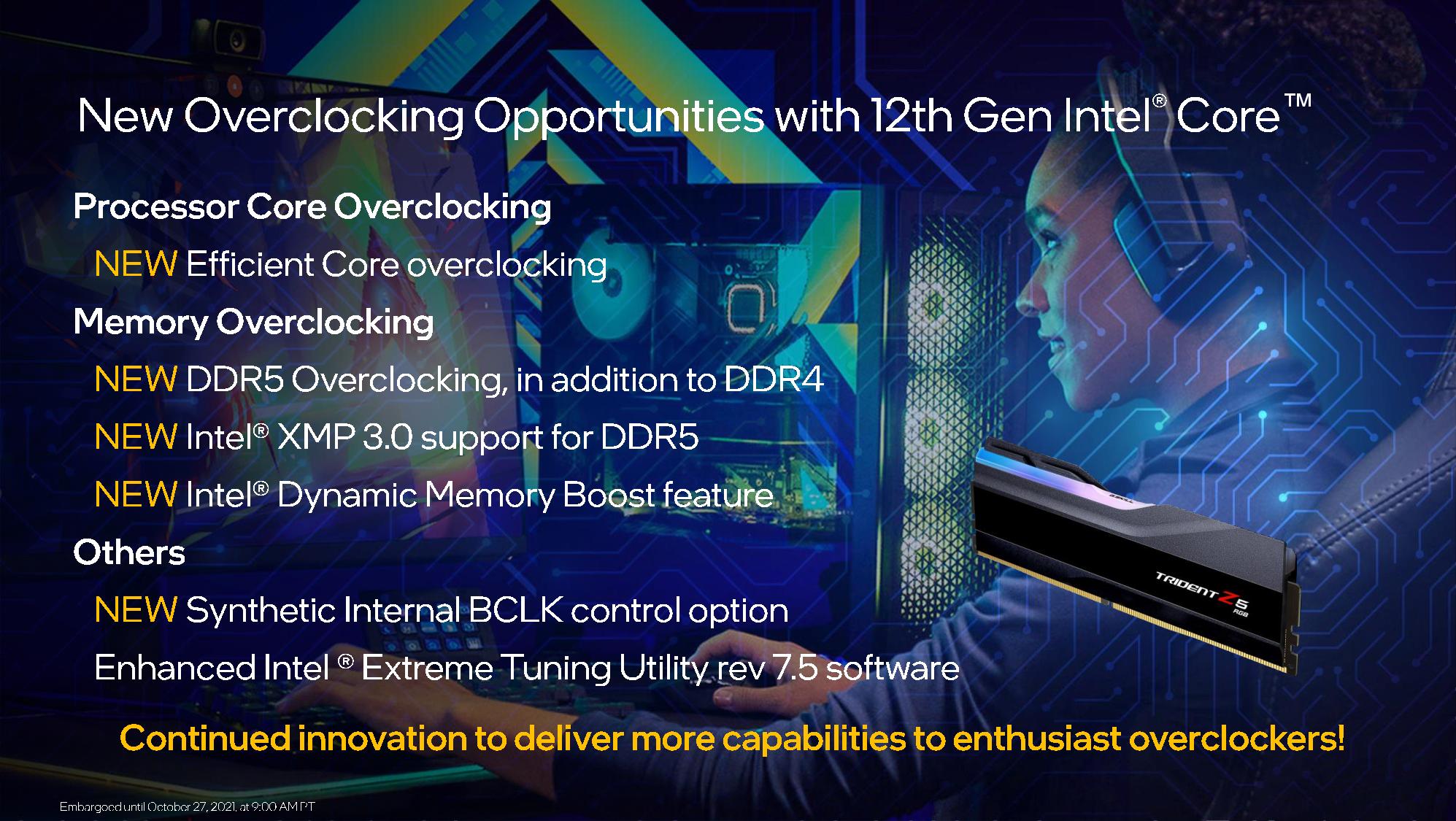

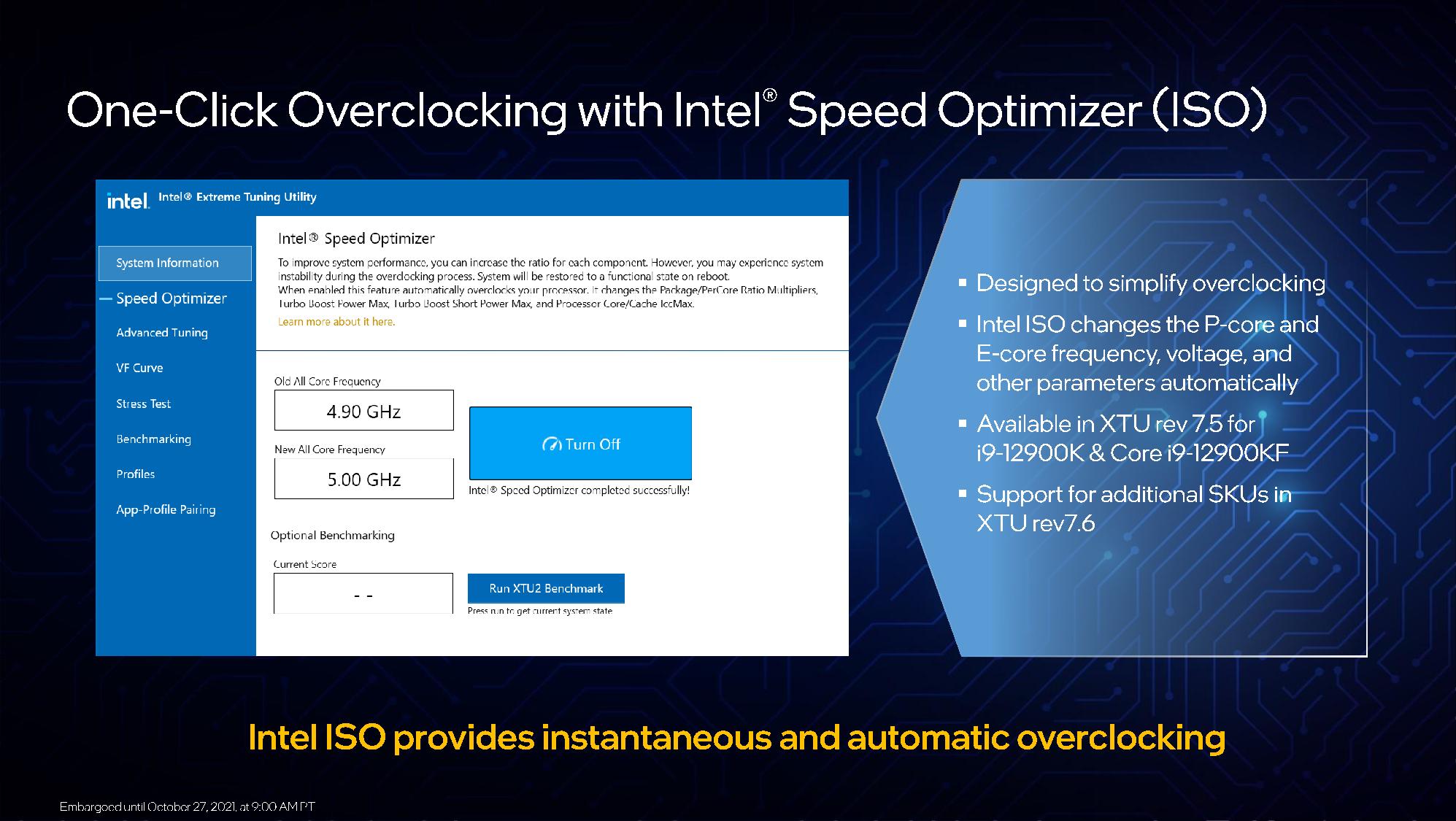

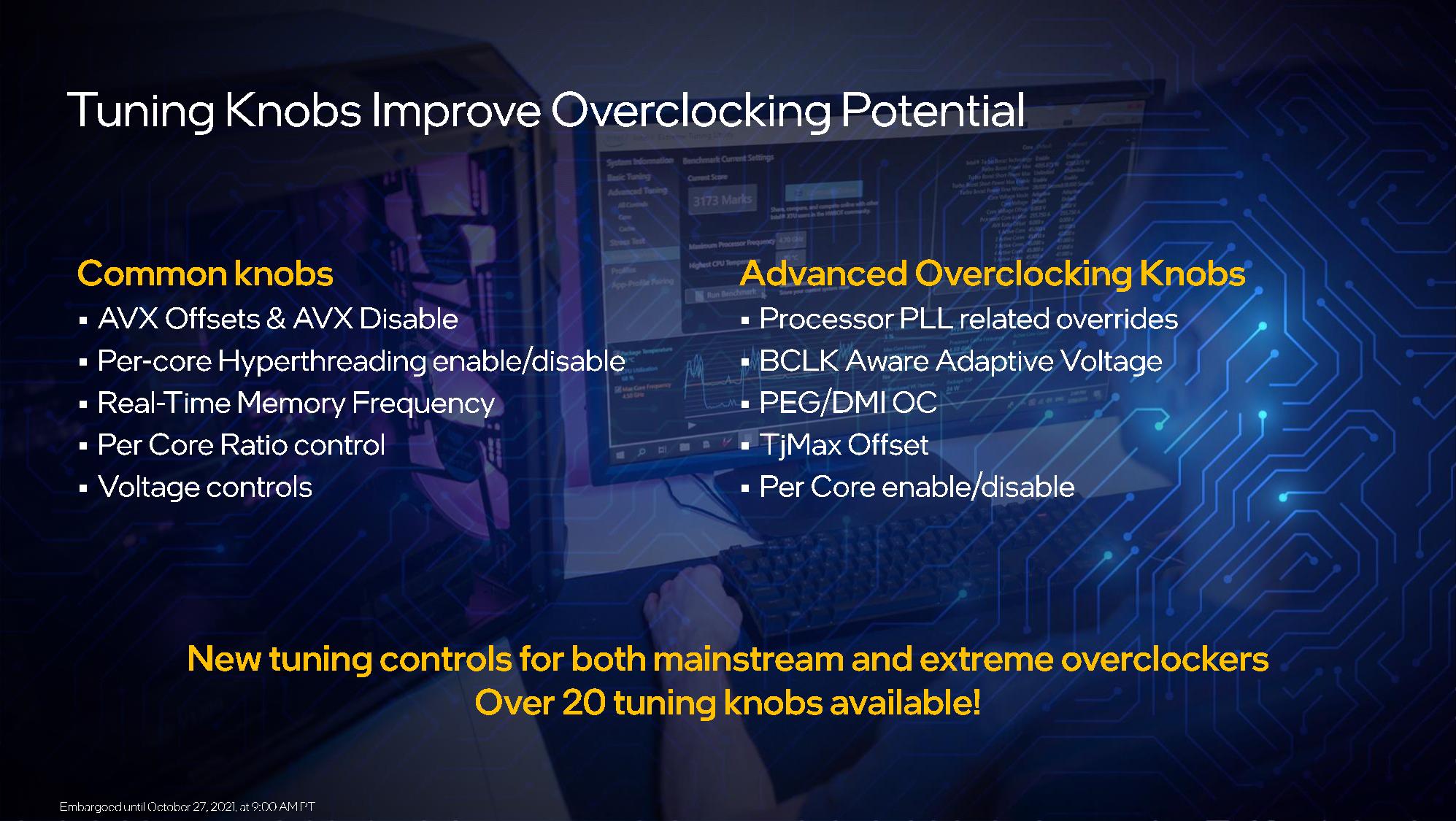

Intel has enabled overclocking the E-cores separately from the P-cores, but you'll have to overclock the smaller cores in groups of four. Interestingly, you can disable all of the E-cores if you'd like, but one P-core has to remain active regardless of the configuration — you can't disable all of the P-cores.
Intel's new Speed Optimizer, which is built right into the latest version of its XTU software, automatically raises the Core i9-12900K's P-cores by 100 MHz and the E-cores by 300 MHz, settings both core types to run at an all-core frequency. Think of this as a push-button overclock. Notably, this isn't a dynamic adjustment — it applies to all Core i9-12900K's, signaling that Intel believes there is an easy and quasi-assured amount of overclocking headroom that any Core i9 can achieve, regardless of the silicon lottery. Naturally, manual overclocking should eke out more headroom. Intel will introduce profiles for Core i7 and i5 via an XTU update soon, but we aren't assured of the assigned overclocks.
Intel's 14nm suffered from reduced overclocking frequency headroom as the company squeezed more of its headroom into the stock settings, so overclockers turned to tuning memory and fabrics to eke out extra gains. Intel has exposed more overclocking settings as time has gone by, and now there's a dizzying array of tunable parameters available on Alder Lake, too. That includes overclocking both core types, the ring/cache frequency, graphics, memory, and BCLK overclocking, which now includes a 'synthetic BCLK' that allows adjustments on motherboards that don't have an external clock generator. Intel will also support memory overclocking on non-Z-series motherboards, just like it did with Rocket Lake, but it hasn't shared the full details yet.
Intel also allows for AVX offsets, disabling AVX, per-core overclocking and hyperthreading enable/disable, real-time memory frequency adjustments while the operating system is running, and exposes a plethora of voltage controls.
Intel has also revamped its XTU software to revision 7.5 and added the requisite new features for Alder Lake chips and DDR5 support and added an HWbot-certified XTU benchmark.
DDR5 Overclocking and XMP 3.0
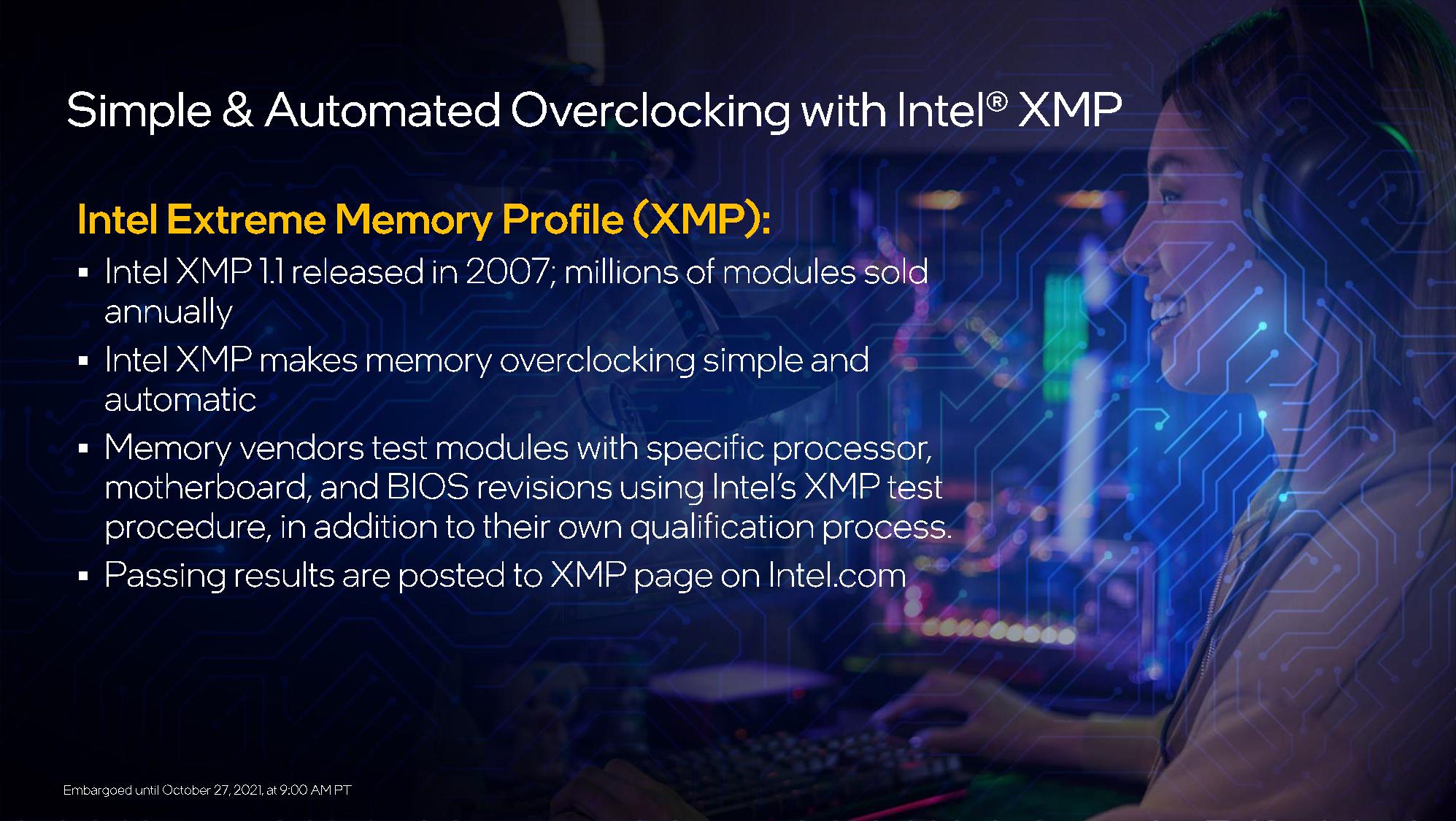
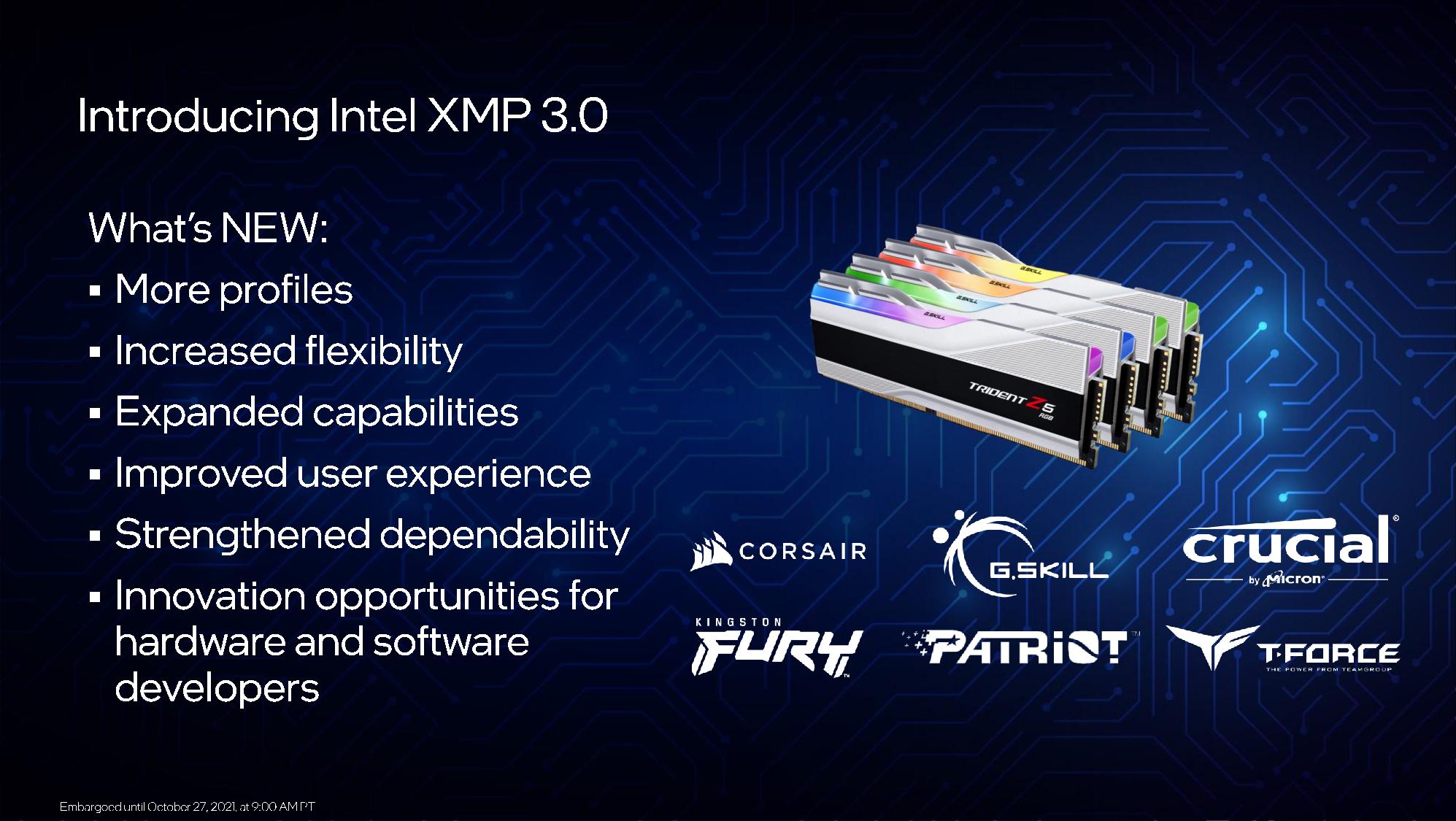

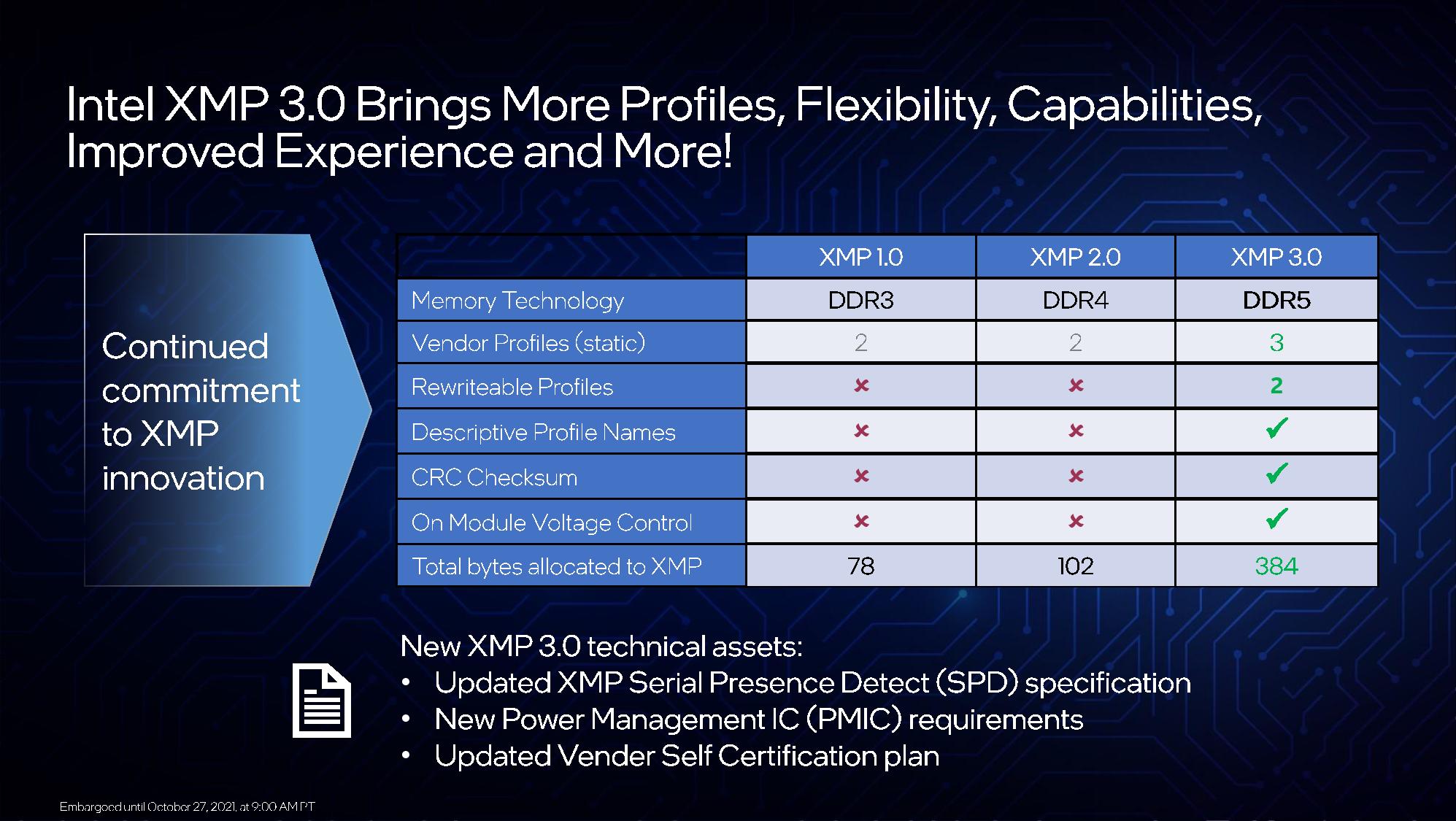
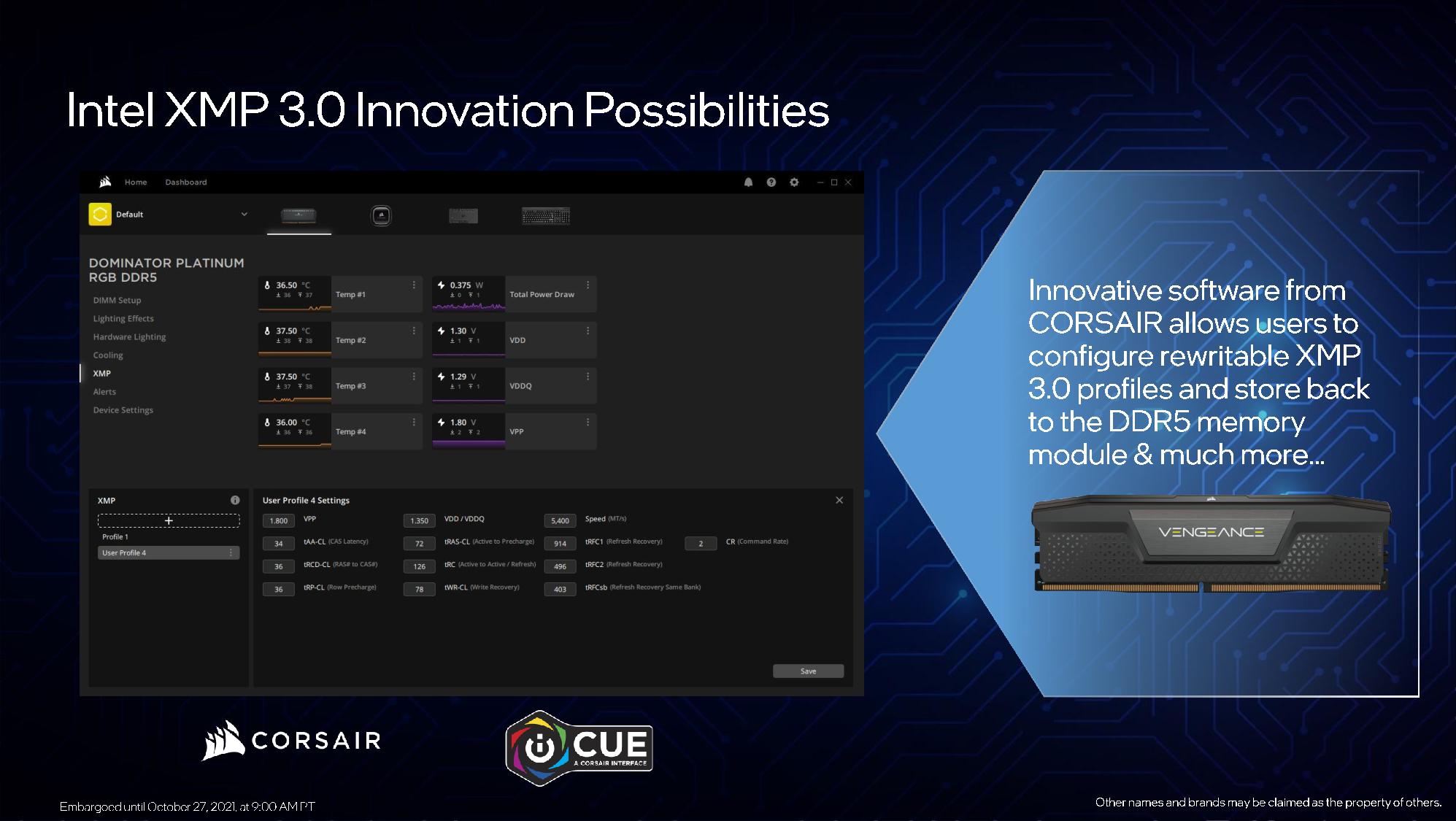
DDR5 opens up a whole new world of memory overclocking, starting with the new XMP 3.0 standard. XMP 3.0 brings support for up to five memory profiles (SPDs) that define frequency, voltage, and latency. That's a big increase from the previous max of two profiles, and XMP 3.0 also lets you write and name two of the profiles. That means you can adjust the frequencies and all the timings and voltages to your liking, assign a name, and save the settings directly to the XMP profile stored in the SPD.
Intel has also exposed the XMP 3.0 mechanisms to outside vendors so they can integrate the new features into software, with an example being a new feature in Corsair's iCue software that allows you to alter your XMP 3.0 profiles.
The new XMP profiles can also control the PMICs (Power Management ICs) now present on DDR5 DIMMs. These new PMIC chips are instrumental in DDR5 overclocking because they control three on-DIMM voltage rails – VDD, VDDQ, and VPP. Intel has defined a common set of PMIC standards among the vendors to define maximum voltages and voltage steps, among other parameters. However, there will be variances in PMIC quality, adding yet another layer to selecting the Best RAM for overclocking.
Vendors can now use a standardized test to self-certify their kits as XMP 3.0 capable with various motherboards, and Intel is hosting a list of eight certified kits on its website, with more to be added soon. The listings even include a compatibility matrix with specific motherboards and firmware revisions to help ensure solid DDR5 XMP profile compatibility.
Dynamic Memory Boost and XMP 3.0
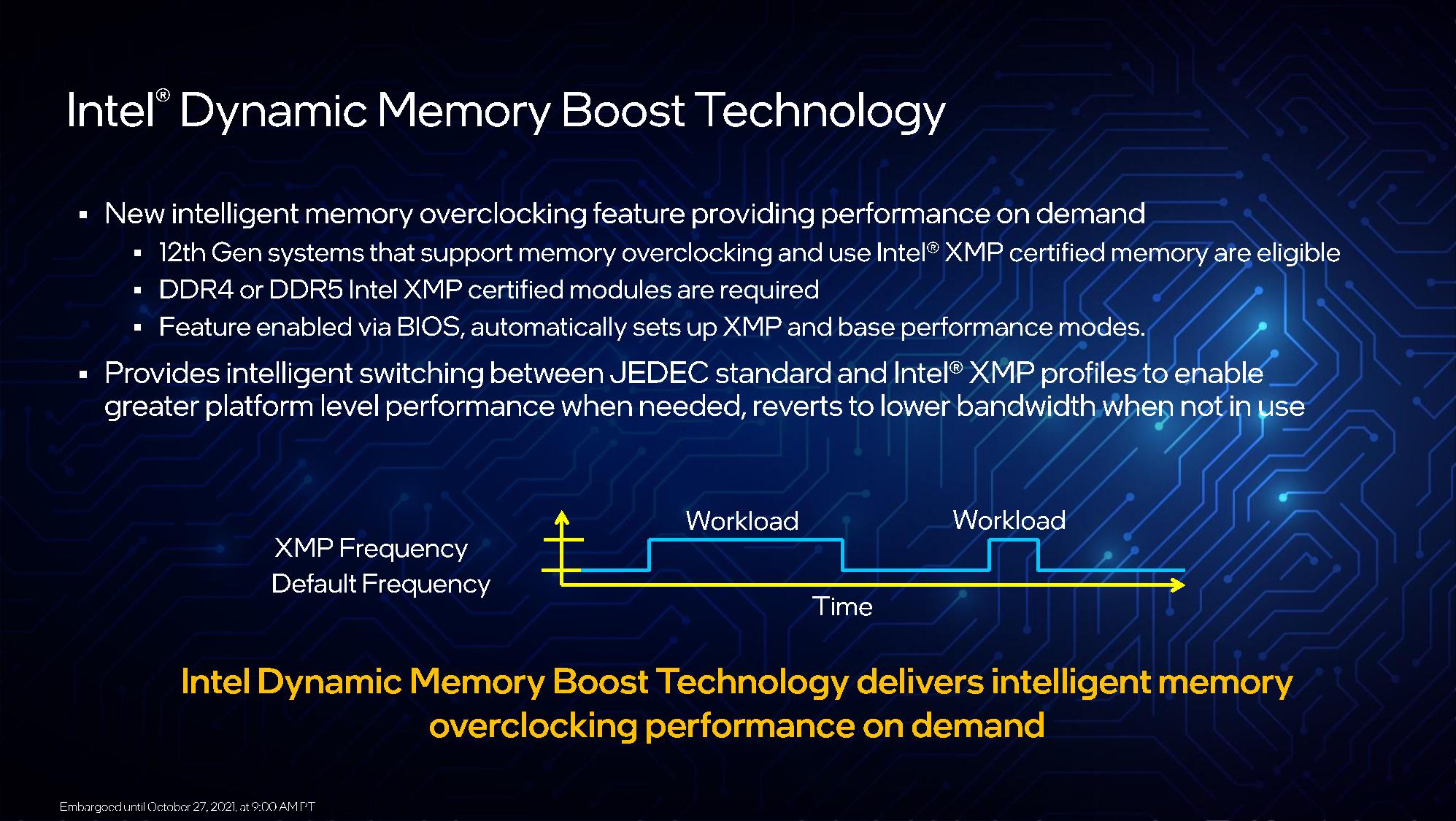
Intel's participating motherboard partners will soon push out BIOS updates that enable Dynamic Memory Overclocking. This new tech works with both DDR4 and DDR5 and allows the system to dynamically switch between standard memory frequencies and timings and an XMP profile, meaning that it will auto-overclock the memory as needed based on the current usage pattern. And yes, this occurs while the operating system is running and doesn't require a reboot — it's a real-time dynamic adjustment.
The Alder Lake processor's PMU will control the dynamic shifts, so there is no software overhead and limited user adjustability. Additionally, not all motherboards will support the feature, so you'll have to ensure it is on the spec list. Intel doesn't require motherboard vendors to support this feature and doesn't provide guidance on whether or not it should be a default setting. We expect it to be an opt-in feature.
- MORE: Best CPUs for Gaming
- MORE: CPU Benchmark Hierarchy
- MORE: AMD vs Intel
- MORE: All CPUs Content
Get Tom's Hardware's best news and in-depth reviews, straight to your inbox.
Current page: Alder Lake Overclocking, DDR5, XMP 3.0 and Dynamic Memory Boost Tech
Prev Page Windows 10 Performance Variability, Thread Director, Performance Gains Next Page Thoughts
Paul Alcorn is the Editor-in-Chief for Tom's Hardware US. He also writes news and reviews on CPUs, storage, and enterprise hardware.
-
wifiburger 589$ is awesome, very interestingReply
If I do upgrade I'll go with DDR4 since I already have a good 4400 bdie kit -
-Fran- Reply
That's the 1K tray pricing, not "plebian" MSRP.wifiburger said:589$ is awesome, very interesting
If I do upgrade I'll go with DDR4 since I already have a good 4400 bdie kit
At retail it'll definitely be more than that. Still, finding it under $700 may be totally possible, so good news there for sure. I'd say it's like at least 20% increase over the prices mentioned.
Seems like Intel is not going ballistic with pricing, so that also hints at them being cautious. Not a bad thing, TBH.
Regards. -
VforV As an AMD user all I care about Alder Lake is the price and I do hope these are the real prices on launch, even if these are only the mythical MSRPs, they should make AMD drop their Zen3 prices too.Reply
So that's good news if true, for me.
Also I like how in their own gaming benchmarks intel has a average of about +15% lead over Zen3, like the same gap Zen3 V-Cache will add. Not the +50% all the synthetic benchmarks and click-bait titles were shouting from the rooftops up until now... -
TerryLaze Reply
Yes and all the big chains that will buy way more than just 1k will get them for cheaper than that.Yuka said:That's the 1K tray pricing, not "plebian" MSRP.
First couple of weeks are going to be higher prices because that always happens, the big question is what will happen after that, if scalpers will be a big issue or if they are going to be sold for more by retailers. -
Roland Of Gilead 'The Alder Lake chips are available for preorder today, but they won't ship until October 4, 2021' - Am I stuck in a time warp! :tearsofjoy: So I could have ordered this 3 weeks ago!?Reply -
-Fran- Reply
I was told Microcenter already has it listed for $650.TerryLaze said:Yes and all the big chains that will buy way more than just 1k will get them for cheaper than that.
First couple of weeks are going to be higher prices because that always happens, the big question is what will happen after that, if scalpers will be a big issue or if they are going to be sold for more by retailers.
Regards. -
TerryLaze Reply
Looking at price history the 11900k was available at exactly the MSRP from day one, not everywhere but still, there is no reason to believe that the 12900k will be different, except for retailers that might take advantage of the situation.Yuka said:I was told Microcenter already has it listed for $650.
Regards.
https://pcpartpicker.com/product/mDcG3C/intel-core-i9-11900k-35-ghz-8-core-processor-bx8070811900k?history_days=365 -
-Fran- Reply
Not disagreeing. I mentioned Microcenter as they're usually your "best case scenario" for retail pricing.TerryLaze said:Looking at price history the 11900k was available at exactly the MSRP from day one, not everywhere but still, there is no reason to believe that the 12900k will be different, except for retailers that might take advantage of the situation.
https://pcpartpicker.com/product/mDcG3C/intel-core-i9-11900k-35-ghz-8-core-processor-bx8070811900k?history_days=365
Regards. -
hotaru251 kind of weird they knowingly posted benchmarks vs a nerfed ryzen os.Reply
should of just omitted it and posted fair ones later.
but props to em for mentioning it. -
nervousstate Reply
Not to mention everything else will be a premium at launch. PCIe5 and DDR5 are not going to make motherboards more affordable and DDR5 is at least 2X the price of DDR4 and overclocking the memory to actually achieve a benefit is still very much unknown and different than DDR3/4 due to the change to the power delivery as well as everything else that is new. We are also going to see the extended L3 Cache launched very soon from amd which they suggested is going to have a 20% improvement along with 16 REAL cores for about the same price as the 5950X - It does look like they have improved Single threaded performance over AMD but youll never get the same performance with 8 Atom Cores. The i5 looks like a compelling offer though. 6C/12T + 4 Low-Power Cores is going to compete well against the 5600X and LP cores will be nice for running docker containers or network services without effecting gaming performance. Unless of course AMD drops the price a little...Yuka said:That's the 1K tray pricing, not "plebian" MSRP.
At retail it'll definitely be more than that. Still, finding it under $700 may be totally possible, so good news there for sure. I'd say it's like at least 20% increase over the prices mentioned.
Seems like Intel is not going ballistic with pricing, so that also hints at them being cautious. Not a bad thing, TBH.
Regards.